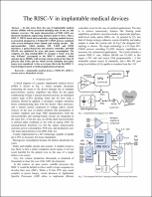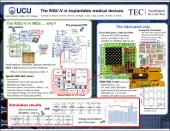JavaScript is disabled for your browser. Some features of this site may not work without it.
Mostrar el registro sencillo del ítem
The RISC-V in implantable medical devices
| dc.contributor.author | Arnaud Maceira, Alfredo | |
| dc.date.accessioned | 2021-10-22T00:33:53Z | |
| dc.date.available | 2021-10-22T00:33:53Z | |
| dc.date.issued | 2019-12 | |
| dc.identifier.uri | https://hdl.handle.net/10895/1558 | |
| dc.description.abstract | In this work, first, the case of implantable medical devices (IMDs) will be presented including state of the art and industry overview. The main characteristics of IMD ASICs are discussed (technical, engineering, business point of view). Then a RISC-V 32RVI based microcontroller, targeting medical devices, is presented, designed in a 0.18μm HV-CMOS process combined with several biological tissue stimuli and sensing circuits. The microcontroller, which includes SPI, UART and GPIO interfaces, a packet-based bus and memory controller, and 8kB SRAM, was optimized for area, and power consumption. The complete test chip (analog+RISC-V) occupies a 5mm2 area but only 0.82mm2 correspond to the RISC-V controller, which operates up to 20MHz, with average energy needs of less than 34 pJ/cycle (3pJ STD), and for which several reliability and safety issues were considered. As far as we know this is the first RISC-V based designed aimed at medical applications proposed. | es |
| dc.description.sponsorship | Agencia Nacional de Investigación e Innovación | |
| dc.format.mimetype | application/pdf | |
| dc.language.iso | en | es |
| dc.publisher | RISC-V | es |
| dc.subject | Implantable medical devices | es |
| dc.subject | CMOS HV | es |
| dc.subject | RISC-V | es |
| dc.subject | Current sources | es |
| dc.subject | Biomedical circuits | es |
| dc.title | The RISC-V in implantable medical devices | es |
| dc.type | Artículo | es |
Ficheros en el ítem
Este ítem aparece en la(s) siguiente(s) colección(ones)
-
Artículos [51]



